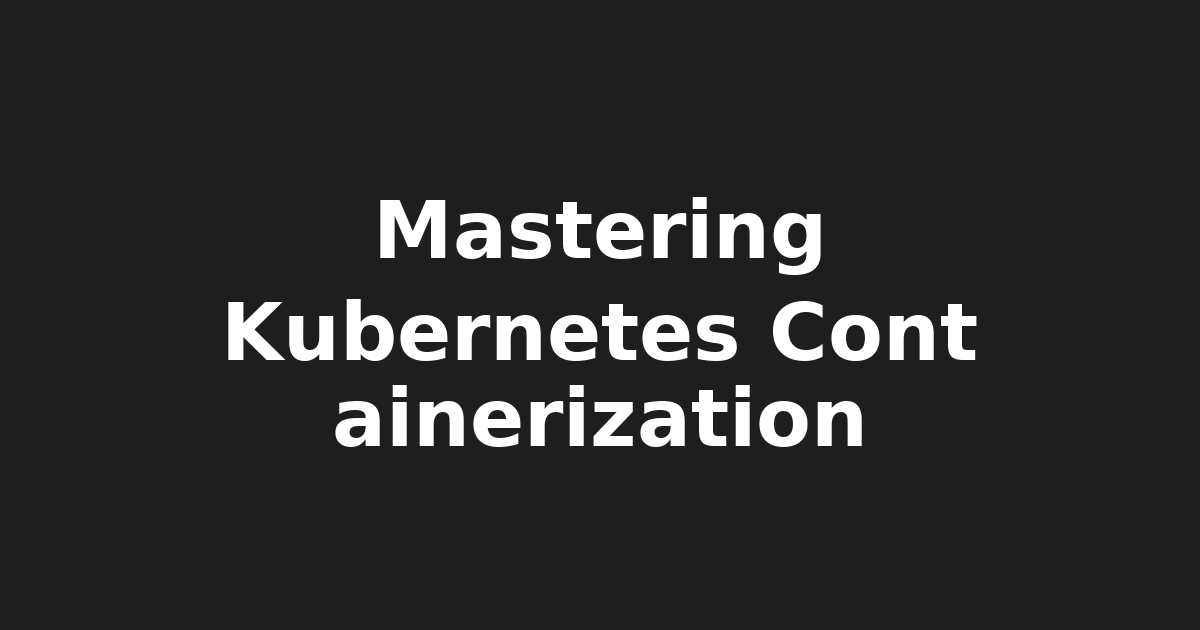Mastering Containerization with Kubernetes and Docker

Containerization with Kubernetes and Docker: A Comprehensive Guide
=====================================================
Containerization has become an essential technology for deploying modern microservices-based systems. With the rise of cloud-native technologies, container orchestration has become crucial for managing and scaling complex applications. In this article, we'll explore the latest trends and best practices for containerization with Kubernetes and Docker.
Why Containerization is Trending
Containerization has seen significant growth in popularity due to its ability to provide a lightweight, portable, and efficient way to deploy applications. Here are some key reasons why containerization is trending:
- Kubernetes Adoption: Kubernetes (k8s) has become the de facto standard for container orchestration, with millions of users worldwide. Its scalability, flexibility, and reliability have made it an essential tool for modern applications.
- Docker Hub Usage: Docker Hub is one of the largest container registries, with over 50 million registered containers. Its popularity has led to a surge in demand for containerization solutions, making it an essential part of any modern application stack.
- Cloud-Native Architecture: As more organizations adopt cloud-native architectures, containerization and orchestration become crucial components of their technology stacks.
Key Benefits of Containerization
Containerization offers several benefits for developers, DevOps teams, and system administrators:
- Improved Scalability: Containerization enables easy scaling and deployment of applications across multiple environments.
- Enhanced Security: Containers provide a secure environment for each application, reducing the risk of contamination or data breaches.
- Increased Efficiency: Automated deployment and management of containers simplify the development and operations process.
Best Practices for Containerization
Here are some best practices to keep in mind when containerizing your applications:
- Use Official Docker Images: Ensure that you're using official Docker images to avoid potential security risks.
- Implement Kubernetes Best Practices: Follow best practices for Kubernetes, such as implementing a service mesh, using persistent volumes, and configuring monitoring and logging.
- Monitor and Optimize Container Performance: Regularly monitor and optimize your containers' performance to ensure they're running efficiently.
Using Official Docker Images
When using official Docker images, make sure to:
docker pull <image-name>
This ensures that you're getting the latest version of the image from the Docker Hub repository.
Implementing Kubernetes Best Practices
Here are some key best practices for implementing Kubernetes:
- Implement a Service Mesh: Use a service mesh like Istio or Linkerd to manage communication between microservices.
- Use Persistent Volumes: Configure persistent volumes to ensure data persistence across container restarts.
- Configure Monitoring and Logging: Set up monitoring and logging tools like Prometheus, Grafana, and ELK Stack.
Monitoring and Optimizing Container Performance
Regularly monitor your containers' performance using tools like:
docker stats
And optimize their performance by adjusting resource allocation, configuring caching mechanisms, and implementing load balancing strategies.
Resources
Here are some resources to help you get started with containerization and orchestration:
- Docker Official Documentation: https://docs.docker.com/
- Kubernetes Official Documentation: https://kubernetes.io/docs
- Cloud-Native Computing Communities on GitHub or Stack Overflow
By staying up-to-date with the latest developments in containerization and orchestration, you can ensure that your applications are running efficiently, securely, and at scale.
Conclusion
Containerization has become an essential technology for deploying modern microservices-based systems. By following best practices and implementing Kubernetes and Docker effectively, you can ensure that your applications are running efficiently, securely, and at scale.
